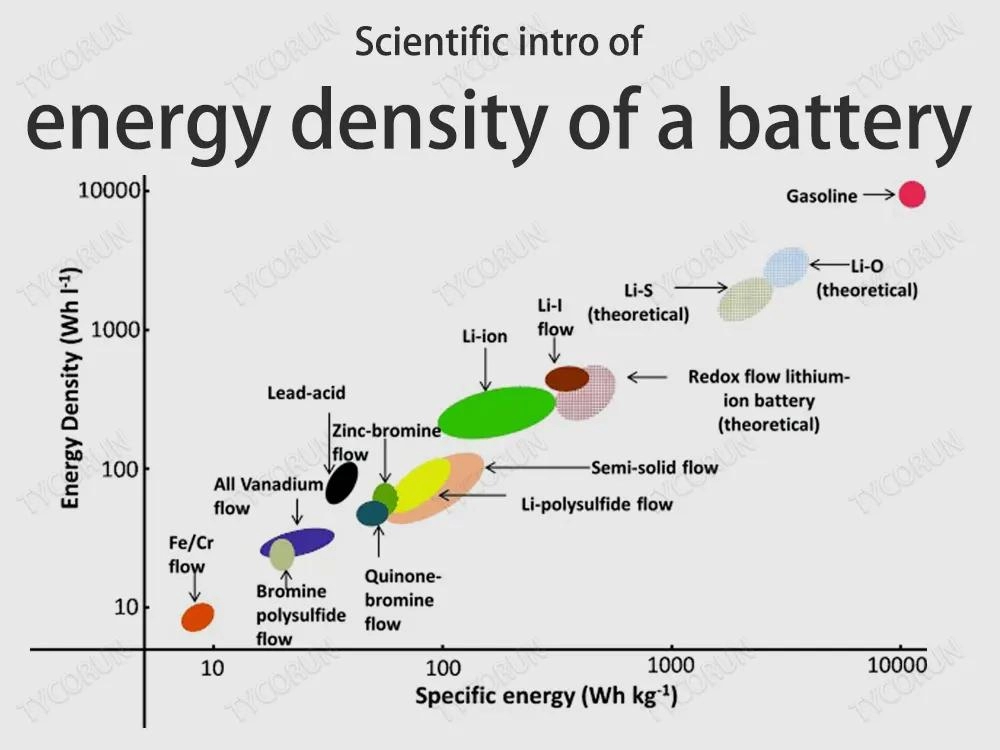markdown
# Understanding Lithium-Ion Battery Energy Density | KHZH
Part 1: What is Energy Density in Lithium-Ion Batteries?
Energy density measures the amount of energy a lithium-ion battery can store per unit of volume (Wh/L) or weight (Wh/kg). It is crucial for optimizing battery performance in mobile devices and electric vehicles (EVs). Expressed in watt-hours per liter (Wh/L) or watt-hours per kilogram (Wh/kg), energy density defines a battery’s storage capacity and power output capabilities. Higher energy density means more energy can be stored in a smaller or lighter package. This results in batteries that last longer, are more efficient, and perform better.
Average Energy Density Values
Lithium-ion batteries typically have energy densities ranging from 150 to 250 Wh/kg and 300 to 700 Wh/L. As battery technology advances, these limits are continuously being pushed, enabling even greater energy storage.
Part 2: Factors Affecting Energy Density in Lithium-Ion Batteries
1. Electrode Materials
The composition of electrode materials plays a decisive role in the energy density of lithium-ion batteries. High-nickel cathodes, such as NMC (Nickel Manganese Cobalt) and NCA (Nickel Cobalt Aluminum), and silicon-based anodes have significantly enhanced energy storage capabilities. Advanced materials with high specific capacity, such as silicon anodes and lithium titanate, are continuously pushing energy density limits while balancing stability and cost-effectiveness.
2. Battery Design and Configuration
The structure and arrangement of internal battery components can impact energy density. Optimizing factors like electrode layering, separator thickness, and overall battery architecture can improve the active material density, leading to enhanced energy storage efficiency.
3. Electrolyte Composition
The electrolyte, responsible for ion transport between electrodes, directly influences energy density. Liquid electrolytes, gel-based alternatives, and solid-state electrolytes affect factors like voltage stability, internal resistance, and overall performance. Solid-state electrolytes, in particular, offer the potential for higher energy densities, improved safety, and longer lifespans.
4. Packing Efficiency
Efficient use of space within battery cells significantly enhances energy density. Minimizing non-active components, such as binders and conductive additives while maximizing the proportion of active materials improves overall performance.
5. Temperature and Operating Conditions
Temperature is crucial to the efficiency of lithium-ion batteries. Extreme conditions can negatively impact ion mobility, electrode reactions, and overall performance. Maintaining optimal operating temperatures is essential to preserve high energy density and prolong battery life.
6. State of Charge and Cycling Behavior
The energy density of a battery is influenced by its state of charge and the number of charge-discharge cycles it undergoes. Factors such as depth of discharge, charging rate, and cycling patterns can affect the degradation of active materials, which impacts long-term energy density retention.
Part 3: Types of Lithium-Ion Batteries and Their Energy Densities
Lithium-Ion and Lithium Polymer Batteries
Lithium-Ion Batteries
Lithium-ion batteries typically have energy densities ranging from 150 to 250 Wh/kg and 300 to 700 Wh/L. They are widely used in applications like smartphones, laptops, electric vehicles, and energy storage systems due to their high efficiency and excellent performance. For more information on battery reconditioning and maintaining the health of lithium-ion batteries, you can visit our Battery Reconditioning Guide.
### Lithium-ion Battery Energy Density
Lithium-ion batteries are widely used in various applications due to their relatively high energy density. These batteries power devices such as smartphones, laptops, electric vehicles (EVs), and even grid-scale energy storage systems, thanks to their high energy-to-weight and energy-to-volume ratios. The energy density of lithium-ion batteries typically ranges from 150 to 250 Wh/kg or 300 to 700 Wh/L.
Lithium-Polymer Batteries
Lithium-polymer batteries are a variant of lithium-ion batteries with a slightly lower energy density, typically ranging from 100 to 200 Wh/kg or 200 to 400 Wh/L. While they have a slightly lower energy density, the main advantage of lithium-polymer batteries is their flexibility, allowing them to be shaped into thinner or custom designs. This makes them ideal for applications where size and space are crucial, such as wearable devices and custom electronic shapes.
Lithium Iron Phosphate Batteries (LiFePO4)
Lithium Iron Phosphate (LiFePO4) batteries have a slightly lower energy density compared to standard lithium-ion batteries, typically ranging from 90 to 120 Wh/kg or 180 to 240 Wh/L. However, their primary advantage lies in their superior safety and long cycle life. These batteries are ideal for applications where safety and stability are paramount, including power tools, medical equipment, and grid-scale energy storage systems.
Other Lithium Batteries
Lithium-Sulfur Batteries (Li-S)
Lithium-sulfur batteries theoretically have
# Understanding Battery Energy Density and Power Density
What is the Highest Energy Density of a Lithium-Ion Battery?
The latest advancements in lithium-ion battery technology have achieved energy densities of around 250 watt-hours per kilogram (Wh/kg). While this represents an ideal scenario, practical applications are often limited by factors such as cycle life and material stability.
Which Battery Has the Highest Power Density?
Among commercially available battery types, lithium polymer (LiPo) batteries generally offer the highest power density. Its flexible design allows for various form factors, making it a top choice for applications requiring high discharge rates.
Energy Density vs. Power Density in Batteries
- Energy density measures the amount of energy a battery can store per unit mass or volume, expressed in watt-hours per kilogram (Wh/kg) or per liter (Wh/L).
- Power density refers to the rate at which a battery releases or absorbs energy per unit mass, measured in watts per kilogram (W/kg).
Batteries with high energy density store more energy and last longer, while those with high power density are optimized for rapid charge and discharge cycles.
What is the Energy Density of Lithium?
Pure lithium metal has a very high energy density of approximately 3,860 Wh/kg.
Related Articles
14250 Battery Guide: Specs, Applications, and Unique Features
The 14250 lithium battery offers high energy density and long-lasting performance.
The Role of lithium hexafluorophosphate and Sodium Chloride in Battery Electrolytes
LiPF₆ and NaCl play crucial roles in advancing battery technology.








